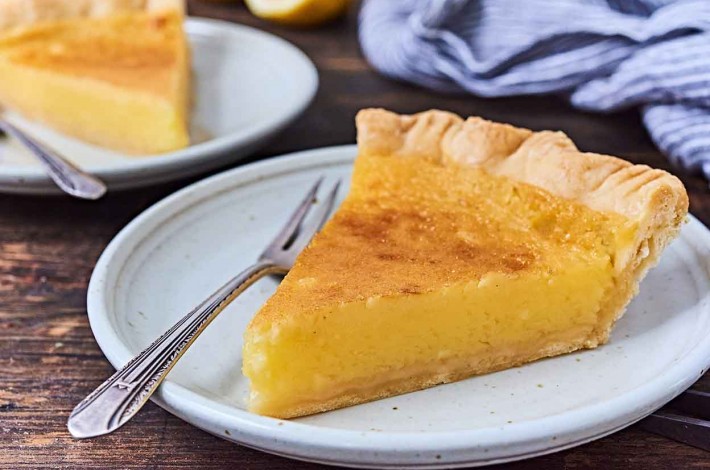


What's your favorite flavor?
We're talking baking now; answers like cilantro, umami, and Kettle Chip Spicy Thai are off limits.
We posed this question on our Facebook page several months ago, and the results were surprising – at least to me.
So, what's everyone's favorite flavor?
Chocolate, by the merest whisker; a single vote separated it from vanilla, the runner-up.
And what's surprising about that, you say?
Nothing. It was the third-place choice that caught me by surprise: lemon.
Lemon? Not caramel or butterscotch, mocha or strawberry or coconut?
Nope. Lemon was a very strong third, far ahead of almond, which checked in at #4.
I decided to double-check my results with an internal poll. Hear ye, hear ye, workers in the King Arthur kingdom: what's your favorite flavor?
Chocolate, by a country mile. Guess we're just dyed-in-the-wool chocolate-lovers here.
But lemon was actually a strong second, right up there with vanilla; in fact, lemon was just slightly ahead. Again, I was a bit surprised; I just never think of lemon as a "favorite flavor."
Still... Lemon Bliss Cake is the cake I make most often, after my standby Favorite Fudge Birthday Cake. And the biscotti I make most often? Lemon-almond.
I love lemon meringue pie – that tart-sweet filling, the perfect complement of lightly sweet meringue – yet I seldom make it. Dealing with the meringue is one step too many. Will it brown? Will it weep? Meringue can be SO needy... Thus my delight at discovering this meringue-less lemon pie: Lemon Chess.
Chess pie? No one seems certain where the name for this pie comes from. A simple combination of eggs, sugar, and butter, with the tiniest bit of flour or cornmeal for thickening, chess pies appeared in print as early as the late 19th century.
Some food historians say "chess" is a takeoff on "cheese," as in English cheese pies, as in American cheesecake – whose filing is of a consistency similar to chess pie.
Others say chess refers to the chest in which pies used to be kept; due to the high degree of sugar, chess pies didn't need to be refrigerated (though in these days of heightened awareness of food safety, we do recommend refrigeration).
One final theory holds that chess refers to the simplicity of the pie itself. "What kind of pie is that?" "Jes' pie." Chess pie.
Whatever its provenance, this pie is perfect for those of you who love lemon, but don't like the somewhat "gluey" texture (or "needy" meringue) of a classic lemon meringue pie. This humble pie has no meringue to hide beneath; it's just lemon at its simple best.
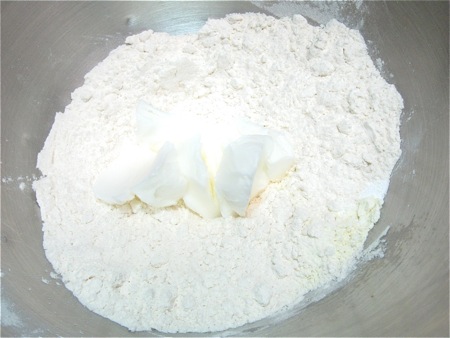
Let's start with the crust. Feel free to use your own favorite pastry for a 9", single-crust pie. Here's one of our go-to pie crust recipes.
Place the following in a mixing bowl:
1 1/2 cups King Arthur Unbleached All-Purpose Flour (177g) or Perfect Pastry Blend (170g)
1 tablespoon (9g) buttermilk powder (optional, for tenderness and flavor)
1/4 teaspoon salt
1/4 teaspoon baking powder (optional, for flakiness)
Whisk everything together. Set aside about 3 tablespoons of the mixture; you'll use it in a minute.
Add 1/4 cup (43g) vegetable shortening, working it in until it's well combined with the dry ingredients.
Can you use butter in place of shortening? Sure; your crust will be less flaky, more sandy/crumbly. All good.

Place the reserved flour mixture on a clean work surface. Add 4 tablespoons (57g) cold butter, and coat it in the flour.

Use a rolling pin or the heel of your hand to flatten the butter to about 1/4" thick.

Break the flour-coated butter into 1" pieces, and mix it into the dough, just until it's evenly distributed; some of it will break into smaller pieces.

Sprinkle 1 teaspoon white or cider vinegar atop the dry ingredients; this will help tenderize the gluten in the flour.

Add 3 tablespoons (43g) ice water while tossing with a fork, or mixing slowly.

Just as soon as the dough becomes cohesive (i.e., you can squeeze it into a ball easily), stop mixing; there should still be visible pieces of fat in the dough.

Add up to 2 additional tablespoons water, if necessary, to make the dough come together.
Flatten the dough into a disk and wrap it in plastic wrap. Refrigerate for 30 minutes or longer; this resting period allows the flour to absorb the water and the gluten to relax, making the dough easier to roll out.

Place the chilled dough on your floured work surface.
I'm using a silicone rolling mat here; it makes cleanup SO easy.

Shape the dough into a rough rectangle...
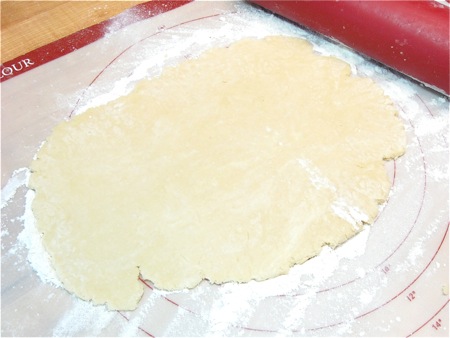
...then roll it into a 12" x 9" (approximately) rectangle/oval.
If it isn't holding together well, sprinkle it lightly with a couple of teaspoons of water.

Fold the dough into thirds (like a letter). Fold one end into the center...

...and the other end over the first.
What's up with all this? We're creating layers of dough, which should translate to flaky pastry.

Fold the dough into thirds the opposite way...

...to form a rough square. Wrap it well and refrigerate again.
When you're "ready to roll," remove the dough from the fridge. Dough made with a combination of butter and shortening should rest for about 5 minutes at room temperature before rolling; dough made with all butter will need a 15-minute rest.
Next, select your pie pan. I'll use a 9" pan. Choose a pan that's 1 1/2" deep, or shallower; you don't want the crust to appear half-empty, as it would in a deep-dish pan.
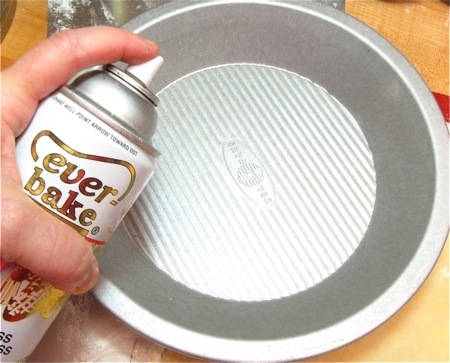
I like to spray my pie pan with non-stick spray, just in case.
Doesn't pastry have enough fat that this isn't necessary? Yes; but if any of the filling leaks out, the spray helps to prevent it from acting as glue between crust and pan.
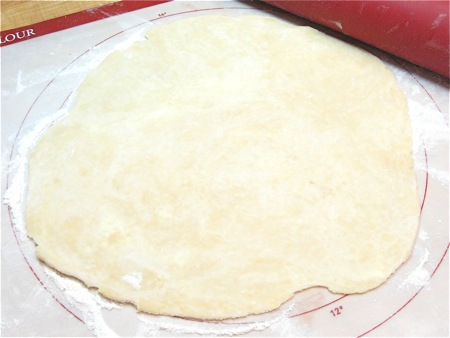
Roll the dough into a 12" to 13" circle. I'm at barely 12" here; it needs to be a bit larger than this, in order for there to be enough crust for a nice crimped edge.
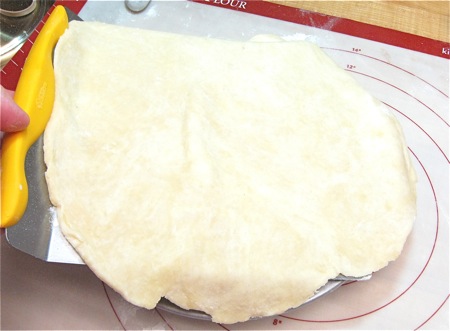
Pick up the crust; a giant spatula works well here.

Yeah, it definitely needed a bit more overhang.

When you find yourself without much crust to spare, make a simple "crimp" by pressing all around the crust with the tines of a fork.

When you've got crust to spare, you can be fancier. Here's a typical crimp.

How about combining the two?
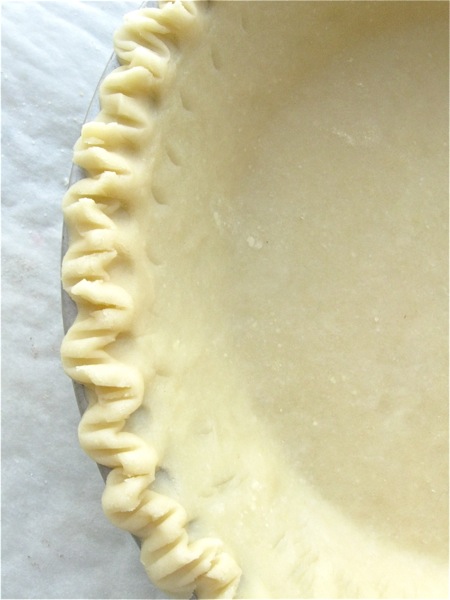
Nice, eh?
Place the crust in the refrigerator (no need to cover it) while you make the filling.
Start preheating the oven to 375°F.

Gather the following:
1 tablespoon cornmeal
1 1/2 tablespoons cornstarch
1 2/3 cups (330g) sugar
1/2 teaspoon salt
6 tablespoons (85g) butter, melted
3/4 cup (170g) fresh lemon juice, the juice from about 3 lemons
5 large eggs, whisked briefly to combine
Whisk together the cornmeal, cornstarch, sugar, and salt. Stir in the melted butter, then the lemon juice. Add the whisked eggs, stirring until everything is well combined.

Pour the filling into the chilled pie shell.
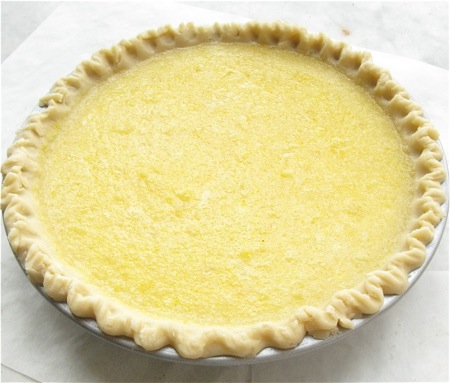
See what I mean about not using a pie pan that's too deep? This amount of filling is just right for a 1 1/2"-deep pan, or one slightly shallower.

Bake the pie on the bottom shelf of the preheated 375°F oven for 45 to 50 minutes, or until the center is set.
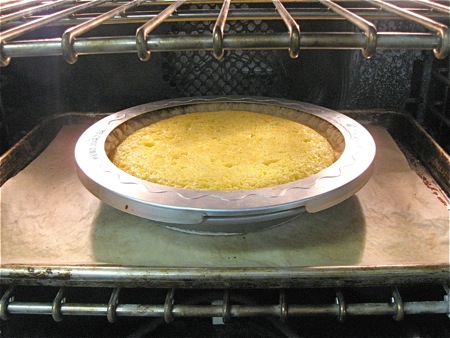
I like to add a pie crust shield about 25 minutes in, or when the edges of the crust are a light, golden brown. The shield will allow the crust to gradually brown without burning, as the filling continues to bake through.

When done, the top of the pie will be golden brown.
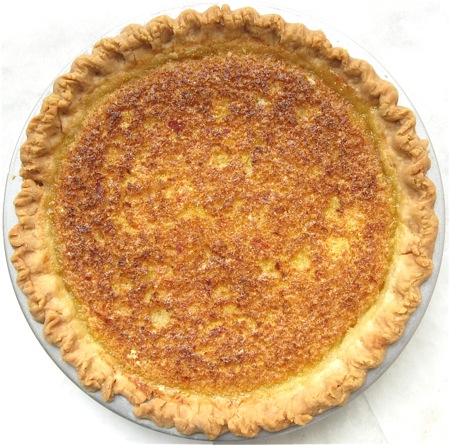
Like this.

Remove the pie from the oven.

Its internal temperature, a couple of inches in from the edge, should be around 210°F or so.

Allow the pie to cool before cutting and serving.
You can just barely begin to see the pie's interesting texture in this photo; imagine a very moist cheesecake... Its flavor, though, is far from cheesecake-y; it's untempered, unabashed lemon, perfect for all your lemon-loving friends and colleagues.
Read, bake, and review (please) our recipe for Lemon Chess Pie.